Rural Industry Revitalization Can Be Energized by Land Transfer: A Case Study in Guangxi Zhuang Autonomous Region, China, 2013–2022
Abstract
1. Introduction
2. Materials and Methods
2.1. Study Area
2.2. Index System Construction
2.3. Data Sources
2.4. Statistical Analysis
3. Results
3.1. The Inter-Annual Trend of RIR and Land Transfer for the Five Cities
3.2. The Driving Forces of RIR
3.3. The Relationship between Land Transfer and RIR
4. Discussion
4.1. Both RIR and Land Transfer Are Closely Bound Up with the National Favorable Treatments to Farmers
4.2. The Mechanism and Analysis of Positive Effects of Land Transfer on RIR from the Target Five Cities in Guangxi
4.3. Sustainable Development Recommendations of RIR and Land Transfer for the Five Target Cities in Guangxi
5. Conclusions
Author Contributions
Funding
Institutional Review Board Statement
Informed Consent Statement
Data Availability Statement
Conflicts of Interest
Appendix A
| Abbreviation | RIR | PTL | TL | FC |
|---|---|---|---|---|
| R2 | R2 | R2 | R2 | |
| BS | 0.933 *** | 0.662 ** | 0.797 ** | 0.948 *** |
| FCG | 0.844 *** | 0.898 *** | 0.879 *** | 0.949 *** |
| GG | 0.834 *** | 0.729 ** | 0.573 * | 0.950 *** |
| GL | 0.972 *** | 0.186 | 0.887 *** | 0.905 *** |
| NN | 0.777 ** | 0.900 *** | 0.970 *** | 0.917 *** |
| Abbreviation | PTL ~ RIR + Year | TL ~ RIR + Year | FC ~ RIR + Year |
|---|---|---|---|
| R2 | R2 | R2 | |
| BS | 0.934 *** | 0.934 *** | 0.939 *** |
| FCG | 0.844 ** | 0.844 ** | 0.845 ** |
| GG | 0.882 *** | 0.914 *** | 0.872 *** |
| GL | 0.978 *** | 0.973 *** | 0.980 *** |
| NN | 0.835 ** | 0.831 ** | 0.780 ** |
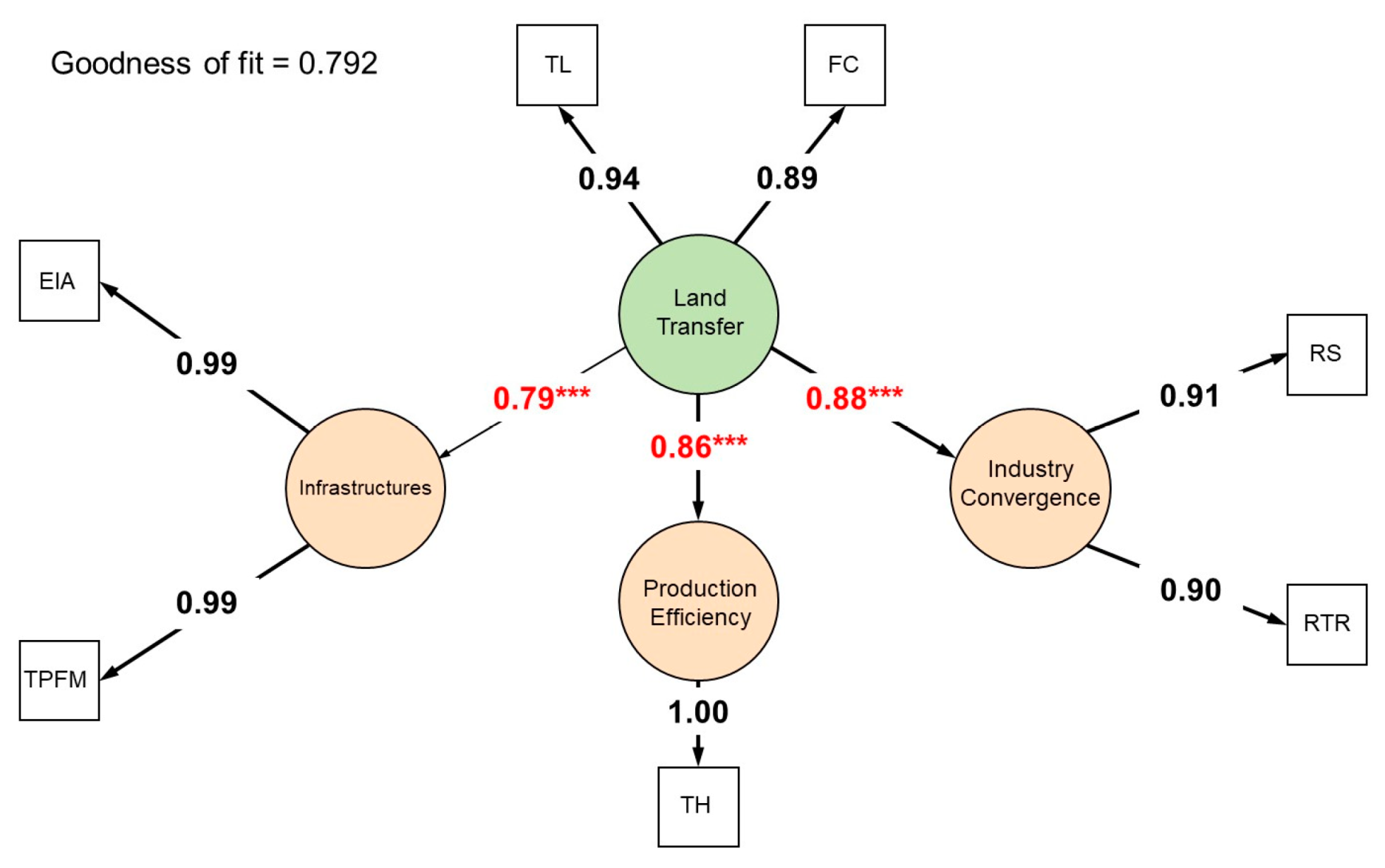
References
- Alkire, S.; Fang, Y. Dynamics of multidimensional poverty and uni-dimensional income poverty: An evidence of stability analysis from China. Soc. Indic. Res. 2019, 142, 25–64. [Google Scholar] [CrossRef]
- Wei, Y.; Tang, B.M. Health shock, social capital and rural household poverty vulnerability. J. Stat. Inform. 2022, 37, 103–116. [Google Scholar]
- Rui, C.; Liu, Y.; Li, Z.; Yi, M. Wang. Research on the dilemma and development path of rural industry revitalization under the background of rural revitalization. BCP Bus. Manag. 2023, 44, 265–269. [Google Scholar] [CrossRef]
- Wang, M.Y.; He, B.; Zhang, J.S.; Jin, Y.N. Analysis of the effect of cooperatives on increasing farmers’ income from the perspective of industry prosperity based on the psm empirical study in shennongjia region. Sustainability 2021, 13, 13172. [Google Scholar] [CrossRef]
- Watanabe, M.; Jinji, N.; Kurihara, M. Is the development of the agro-processing industry pro-poor? The case of thailand. J. Asian Econ. 2009, 20, 443–455. [Google Scholar] [CrossRef]
- Yang, L.; Yang, J.H.; Min, Q.W.; Liu, M.C. Impacts of non-agricultural livelihood transformation of smallholder farmers on agricultural system in the qinghai-tibet plateau. Int. J. Agric. Sustain. 2021, 20, 302–311. [Google Scholar] [CrossRef]
- Lu, D.M.; Yang, X.J.; Shi, Y.Z.; Wang, Z.Q. Rural regime shifts and transformation development on the Loess Plateau. Acta Geogr. Sin. 2020, 75, 348–364. (In Chinese) [Google Scholar]
- Wu, K.; Kong, D.; Yang, X. The impact of rural industrial development on farmers’ livelihoods—Taking fruit-producing area as an example. Land 2023, 12, 1478. [Google Scholar] [CrossRef]
- Yan, Z.; Yang, Z.; Zhong, W. Primary exploration of operation model and strategy of rural land circulation from the perspective of anti-poverty development. IOP Conf. Ser. Earth Environ. Sci. 2019, 267, 062004. [Google Scholar]
- Yu, W.; Guan, G.; Wang, Y.; Wang, Q. An analysis of the poverty reduction effects on land transfer: Evidence from rural areas in China. PLoS ONE 2024, 19, e0298243. [Google Scholar] [CrossRef]
- Zhou, Y.; Li, X.; Liu, Y. Rural land system reforms in China: History, issues, measures and prospects. Land Use Policy 2020, 91, 104330. [Google Scholar] [CrossRef]
- Qiu, T.; Luo, B.; Tang, L.; He, Q. Does land tenure security increase the marketization of land rentals between acquaintances? Appl. Econ. Lett. 2022, 29, 790–793. [Google Scholar] [CrossRef]
- Yu, X.; Su, Q.; Lyu, J. Does access to credit matter in land transfer decision-making? Evidence from China. Front. Environ. Sci. 2023, 11, 1111089. [Google Scholar] [CrossRef]
- Wang, P.; Wang, F. A study of the impact of land transfer decisions on household income in rural China. PLoS ONE 2022, 17, e0276559. [Google Scholar] [CrossRef]
- Liu, H.; Zhang, H.; Xu, Y.; Xue, Y. Decision-making mechanism of farmers in land transfer processes based on sustainable livelihood analysis framework: A study in rural China. Land 2024, 13, 640. [Google Scholar] [CrossRef]
- Zhu, B.; Zhu, X.; Zhang, R.; Zhao, X. Study of multiple land use planning based on the coordinated development of wetland farmland: A case study of Fuyuan City, China. Sustainability 2019, 11, 271. [Google Scholar] [CrossRef]
- Yu, H.; Zhang, W.; Pang, S. Exploring the role of land transfer and social capital in improving agricultural income under the background of rural revitalization. Int. J. Environ. Res. Public Health 2022, 19, 17077. [Google Scholar] [CrossRef] [PubMed]
- Huo, C.; Chen, L. The impact of land transfer policy on sustainable agricultural development in China. Sci. Rep. 2024, 14, 7064. [Google Scholar] [CrossRef] [PubMed]
- Chen, Y.; Li, M.; Zhang, Z. Does the rural land transfer promote the non-grain production of cultivated land in China? Land 2023, 12, 688. [Google Scholar] [CrossRef]
- Rada, N.; Fuglie, K. New perspectives on farm size and productivity. Food Policy 2019, 84, 147–152. [Google Scholar] [CrossRef]
- Fei, R.; Lin, Z.; Chunga, J. How land transfer affects agricultural land use efficiency: Evidence from China’s agricultural sector. Land Use Policy 2021, 103, 105300. [Google Scholar] [CrossRef]
- Cui, B.; Tang, L.; Liu, J.; Sriboonchitta, S. How does land transfer impact the household labor productivity in China? Empirical evidence from survey data in Shandong. Land 2023, 12, 881. [Google Scholar] [CrossRef]
- Zhu, J.; Ma, S.; Zhou, Q. Industrial revitalization of rural villages via comprehensive land consolidation: Case studies in Gansu, China. Land 2022, 11, 1307. [Google Scholar] [CrossRef]
- Xie, D.; Bai, C.; Wang, H.; Xue, Q. The land system and the rise and fall of China’s rural industrialization: Based on the perspective of institutional change of rural collective construction land. Land 2022, 11, 960. [Google Scholar] [CrossRef]
- Wang, Y.; Cao, X. Village evaluation and classification guidance of a county in southeast gansu based on the rural revitalization strategy. Land 2022, 11, 857. [Google Scholar] [CrossRef]
- Zheng, G.; Wang, W.; Jiang, C.; Jiang, F. Can rural industrial convergence improve the total factor productivity of agricultural environments: Evidence from China. Sustainability 2023, 15, 16432. [Google Scholar] [CrossRef]
- Yang, X.; Li, W.; Zhang, P.; Chen, H.; Lai, M.; Zhao, S. The dynamics and driving mechanisms of rural revitalization in western China. Agriculture 2023, 13, 1448. [Google Scholar] [CrossRef]
- Wang, S.; Zhu, J.; Wang, L.; Zhong, S. The inhibitory effect of agricultural fiscal expenditure on agricultural green total factor productivity. Sci. Rep. 2022, 12, 20933. [Google Scholar] [CrossRef]
- Zhang, S.; Zhang, X. Fiscal agricultural expenditures’ impact on sustainable agricultural economic development: Dynamic marginal effects and impact mechanism. PLoS ONE 2024, 19, e0299070. [Google Scholar] [CrossRef]
- Li, X.; Zhang, W.; Peng, Y. Grain output and cultivated land preservation: Assessment of the rewarded land conversion quotas trading policy in China’s Zhejiang Province. Sustainability 2016, 8, 821. [Google Scholar] [CrossRef]
- Trbic, G.; Popov, T.; Djurdjevic, V.; Milunovic, I.; Dejanovic, T.; Gnjato, S.; Ivanisevic, M. Climate change in bosnia and herzegovina according to climate scenario RCP8.5 and possible impact on fruit production. Atmosphere 2022, 13, 1. [Google Scholar] [CrossRef]
- Liu, G. Specific implementation strategies for rural revitalization strategies to help agricultural and rural economic development. Appl. Math. Nonlinear Sci. 2024, 9, 1–18. [Google Scholar] [CrossRef]
- Li, J. Research on the influence mechanism and effect of rural industrial convergence on urban-rural income gap—An empirical analysis based on the Yangtze River Economic Belt. Forest Chem. Rev. 2022, 7–8, 2109–2135. [Google Scholar]
- Liu, C.; Xie, W.; Wu, W.; Zhu, H. Predicting Chinese total retail sales of consumer goods by employing an extended discrete grey polynomial model. Eng. Appl. Artif. Intel. 2021, 102, 104261. [Google Scholar] [CrossRef]
- Hao, W.; Hu, X.; Wang, J.; Zhang, Z.; Shi, Z.; Zhou, H. The impact of farmland fragmentation in China on agricultural productivity. J. Clean. Prod. 2023, 425, 138962. [Google Scholar] [CrossRef]
- Hair, J.F.; Risher, J.J.; Sarstedt, M.; Ringle, C.M. When to use and how to report the results of PLS-SEM. Eur. Bus. Rev. 2018, 31, 2–24. [Google Scholar] [CrossRef]
- Yin, Q.; Sui, X.; Ye, B.; Zhou, Y.; Li, C.; Zou, M.; Zhou, S. What role does land consolidation play in the multi-dimensional rural revitalization in China? A research synthesis. Land Use Policy 2022, 120, 106261. [Google Scholar] [CrossRef]
- Li, Z.; Li, Z.; Mykhailov, A.; Shi, W.; Yang, Z.; Xia, S. Evaluation and analysis of socio-economic development level and management in Guangxi province of China. Stud. Appl. Econ. 2021, 39, 5. [Google Scholar]
- Zhou, Y.; Li, Y.; Xu, C. Land consolidation and rural revitalization in China: Mechanisms and paths. Land Use Policy 2020, 91, 104379. [Google Scholar] [CrossRef]
- Chen, K.Q.; Long, H.L.; Liao, L.W.; Tu, S.S.; Li, T.T. Land use transitions and urban-rural integrated development: Theoretical framework and China’s evidence. Land Use Policy 2020, 92, 104465. [Google Scholar] [CrossRef]
- Muga, G.; Hu, S.; Wang, Z.; Tong, L.; Hu, Z.; Huang, H.; Qu, S. The efficiency of urban–rural integration in the Yangtze River Economic Belt and its optimization. Sustainability 2023, 15, 2419. [Google Scholar] [CrossRef]
- The 40-year evolution and future trend of my country’s agricultural management system. Agr. Econ. Issues 2018, 6, 8–17.
- Pei, C.; Wang, Z.; Sun, J. New concepts, new ideas of shared development. In The Basic Income Distribution System of China; China governance system research series; Springer: Singapore, 2020. [Google Scholar]
- Niroula, G.S.; Thapa, G.B. Impacts and causes of land fragmentation, and lessons learned from land consolidation in South Asia. Land Use Policy 2005, 22, 358–372. [Google Scholar] [CrossRef]
- Li, Y.R.; Li, Y.; Fan, P.C.; Long, H.L. Impacts of land consolidation on rural human–environment system in typical watershed of the Loess Plateau and implications for rural development policy. Land Use Policy 2019, 86, 339–350. [Google Scholar]
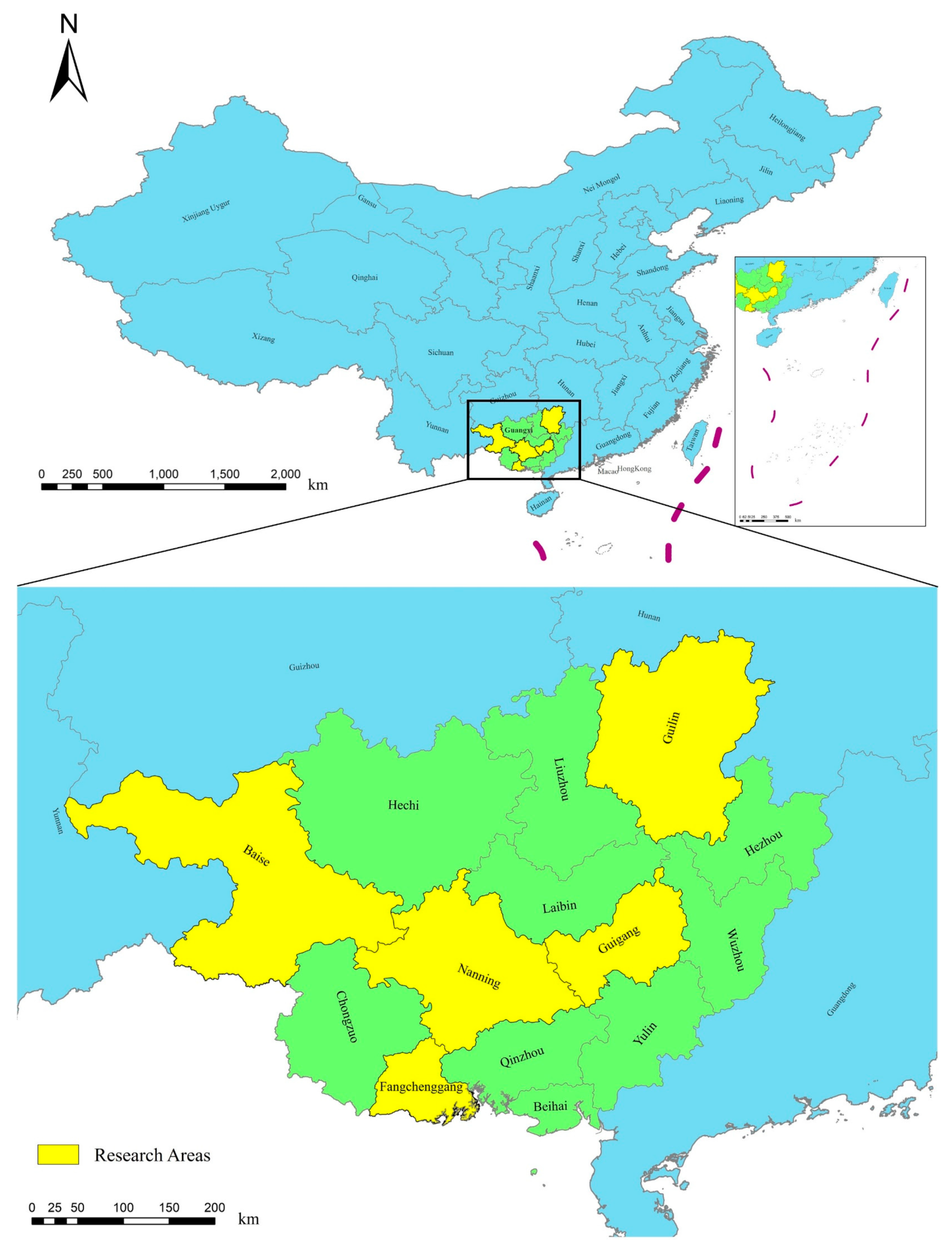

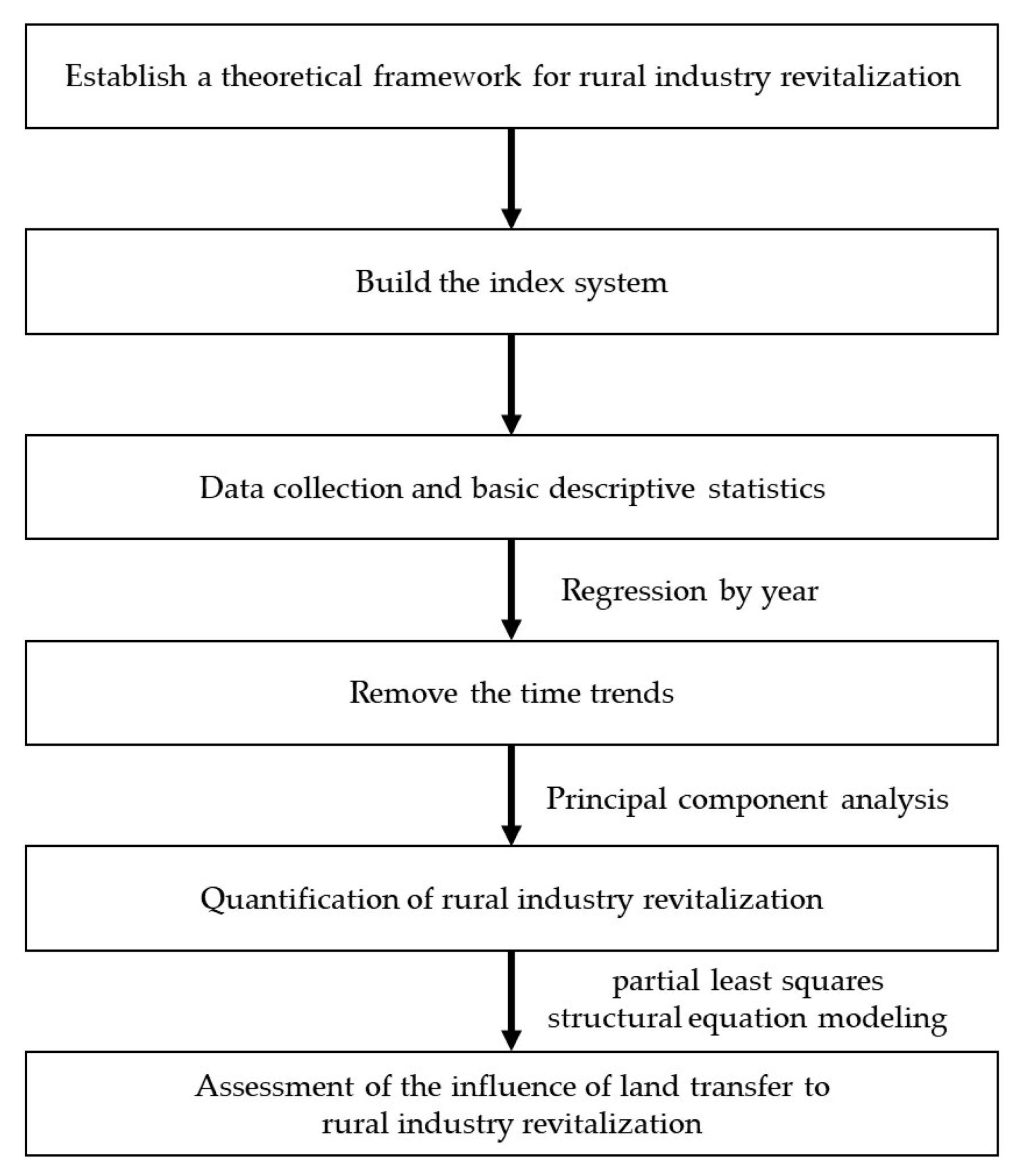
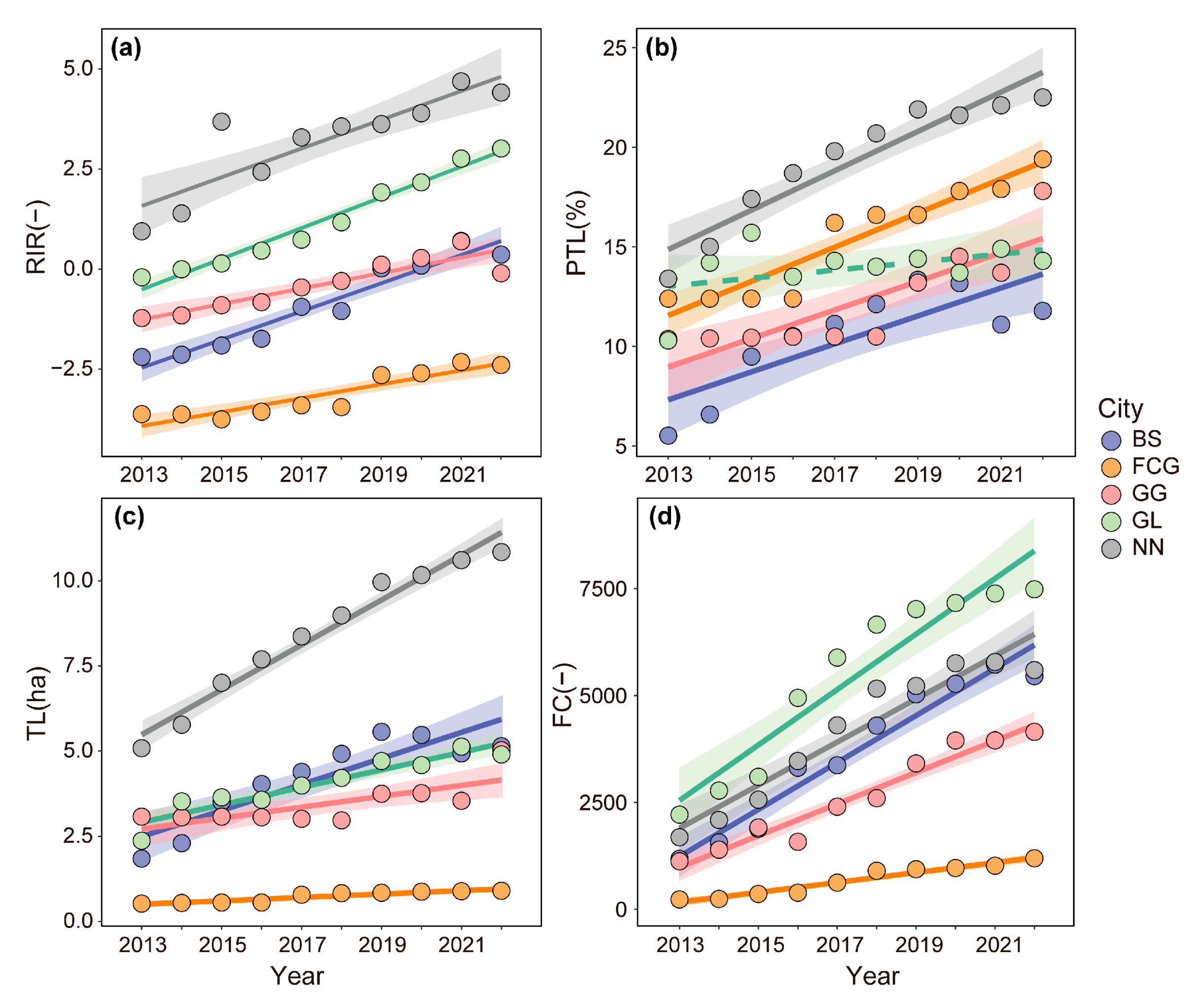
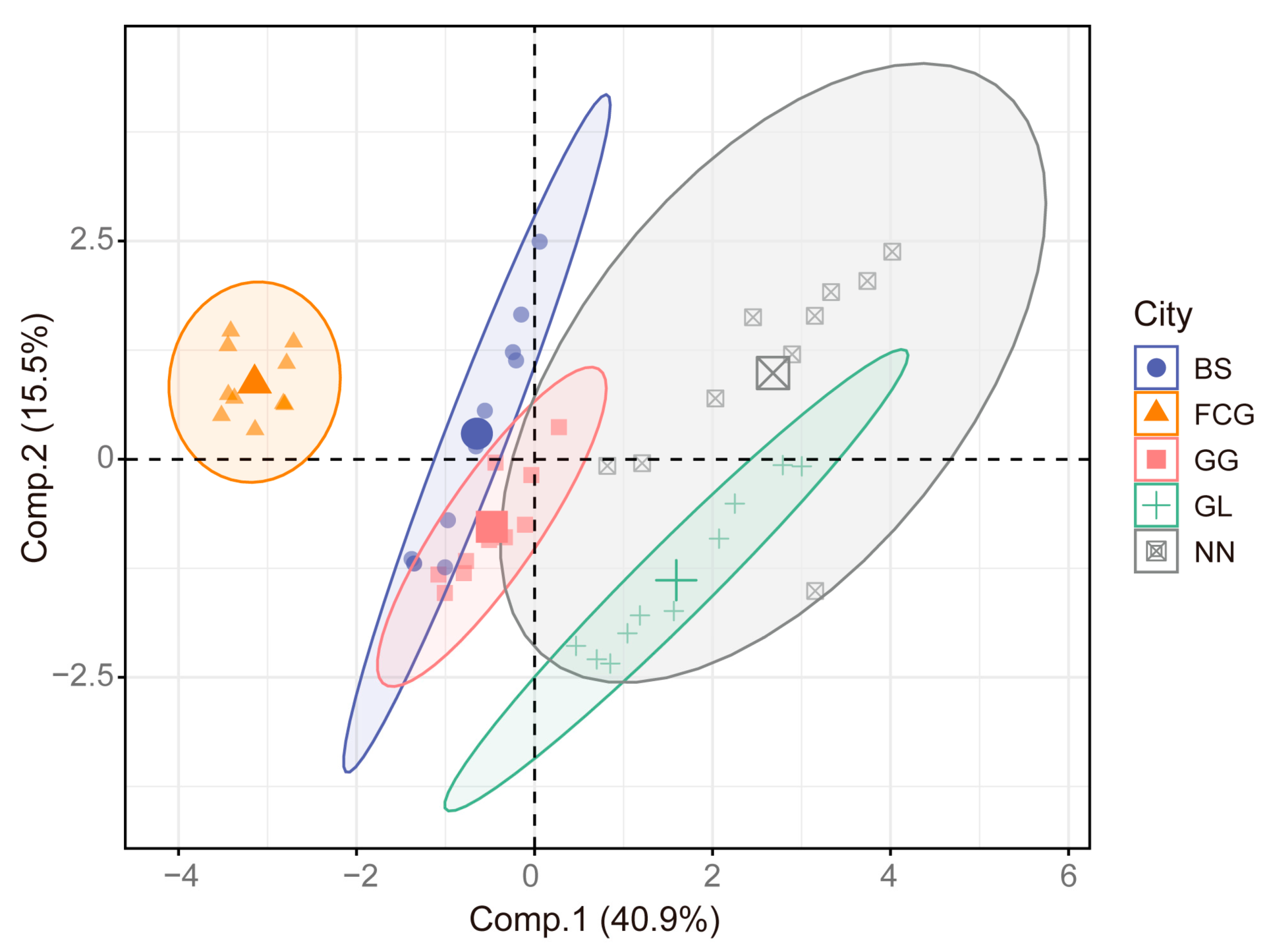

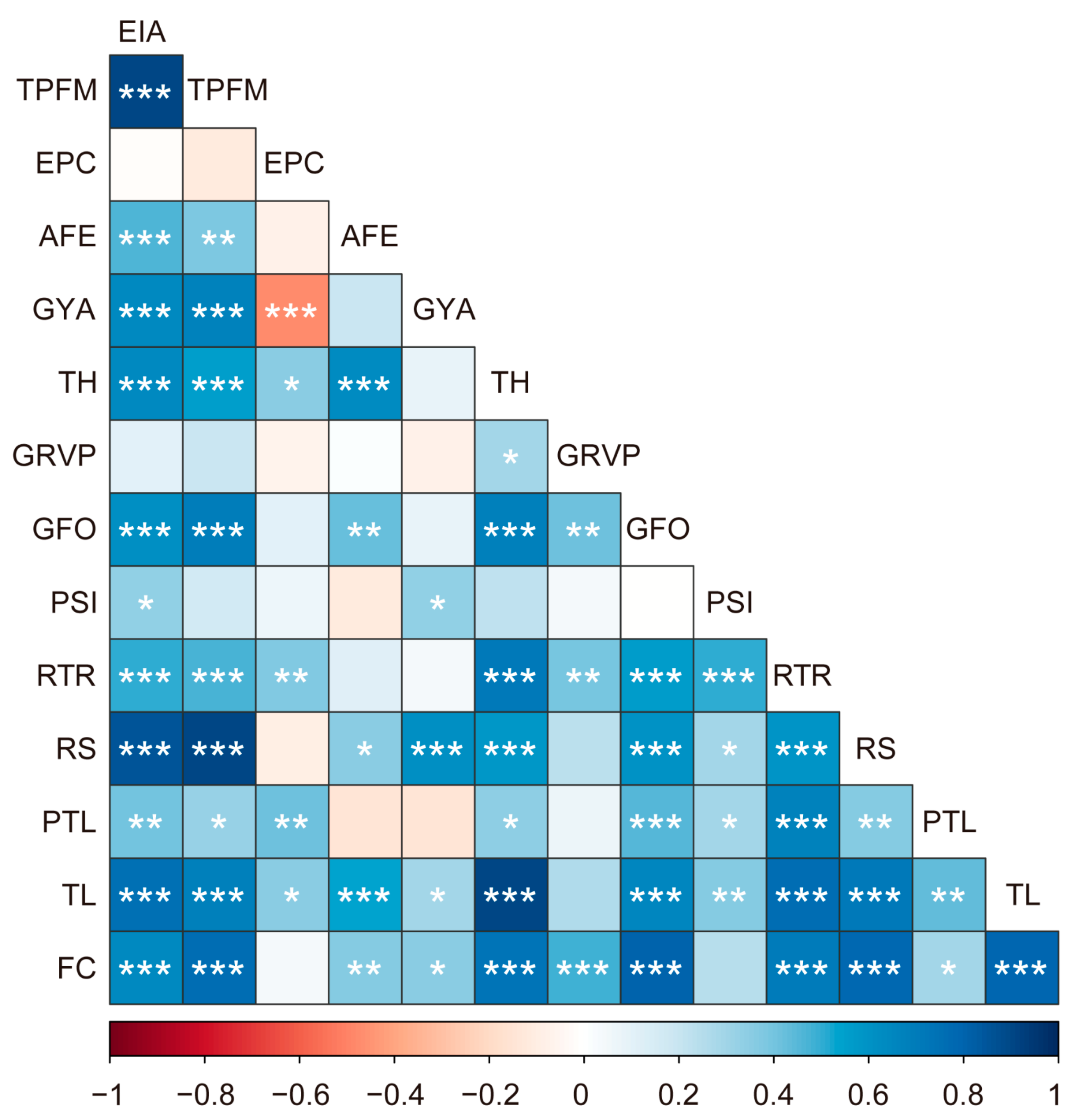

| City | Abbreviation | Location |
Area (km2) | GDP Ranking within Guangxi |
Proportion of Rural Populations | Leading Industries |
|---|---|---|---|---|---|---|
| Nanning | NN | Central | 17,332 | 1 | 40.9% | Electronic manufacturing, machinery, and equipment |
| Guigang | GG | East | 10,602 | 8 | 49.1% | Electric cars and agro-food processing |
| Baise | BS | West | 36,201 | 6 | 75.9% | Aluminum and forestry |
| Fangchenggang | FCG | Southern | 6243 | 12 | 37.1% | Steel and logistics |
| Guilin | GL | Northern | 27,667 | 3 | 45.9% | Tourism and eco-foods |
| Target Layer | First-Level Indices | Second-Level Indices | Description of the Indices (Unit) | Abbreviation | Minimum | Maximum | Mean | Variance |
|---|---|---|---|---|---|---|---|---|
| Development level of rural industry revitalization (RIR) | Infrastructures | Effective irrigation area | The cropland area with water source and complete sets of irrigation facilities (104 ha) | EIA | 2.9 | 25.9 | 15.0 | 55.5 |
| Total power of farm machinery | Total mechanical power of machinery used in agricultural industries (104 kw) | TPFM | 63 | 577 | 356 | 27,999 | ||
| Electric power consumption | Electric power consumption/rural population (kWh per person) | EPC | 155 | 589 | 362 | 13,127 | ||
| Agricultural fiscal expenditures | Fiscal expenditure on agriculture, forestry, and water affairs (108 CNY) | AFE | 10 | 130 | 46 | 801 | ||
| Production efficiency | Grain yield per unit area | Grain yield/the sowing area (103 kg m–2) | GYA | 0.26 | 1.34 | 0.34 | 0.02 | |
| Timber harvests | The volume of timber harvested (104 m3) | TH | 71 | 697 | 268 | 23,922 | ||
| Growth rate of the value added of the primary sector | Percentage change in the added value created by the production activities of primary industries (%) | GRVP | 2.90 | 9.50 | 5.15 | 2.22 | ||
| Garden fruit output | Garden fruit output/rural population (kg per person) | GFO | 95 | 4346 | 922 | 1,009,572 | ||
| Industry convergence | Proportion of the service industries | GDP of the service industries that are related to primary industries/total GDP (%) | PSI | 1.02 | 6.29 | 3.79 | 2.59 | |
| Rural tourism resorts | Number of star-level rural tourism resorts (-) | RTR | 1.0 | 69.0 | 18.5 | 356.8 | ||
| Retail sales | Retail sales of rural consumer goods (108 CNY) | RS | 8.3 | 211.0 | 94.3 | 4556.0 | ||
| Land transfer | Transferred land per capita | Area of the transferred farmland previously owned by rural household/rural population (ha per person) | TL | 0.5 | 10.8 | 4.2 | 7.5 | |
| Proportion of the transferred land | Area of the transferred farmland previously owned by rural household/area of the farmland owned by rural household (%) | PTL | 5.5 | 22.5 | 14.3 | 15.3 | ||
| Farmer cooperatives | Number of famer cooperatives (-) | FC | 230 | 7487 | 3333 | 4,674,933 |
Disclaimer/Publisher’s Note: The statements, opinions and data contained in all publications are solely those of the individual author(s) and contributor(s) and not of MDPI and/or the editor(s). MDPI and/or the editor(s) disclaim responsibility for any injury to people or property resulting from any ideas, methods, instructions or products referred to in the content. |
© 2024 by the authors. Licensee MDPI, Basel, Switzerland. This article is an open access article distributed under the terms and conditions of the Creative Commons Attribution (CC BY) license (https://creativecommons.org/licenses/by/4.0/).
Share and Cite
Yu, Y.; Lang, T.; Pan, M.; Dai, Q.; Liu, Y.; Huang, Y.; Lu, X.; Sun, L.; Wang, Z. Rural Industry Revitalization Can Be Energized by Land Transfer: A Case Study in Guangxi Zhuang Autonomous Region, China, 2013–2022. Sustainability 2024, 16, 6999. https://doi.org/10.3390/su16166999
Yu Y, Lang T, Pan M, Dai Q, Liu Y, Huang Y, Lu X, Sun L, Wang Z. Rural Industry Revitalization Can Be Energized by Land Transfer: A Case Study in Guangxi Zhuang Autonomous Region, China, 2013–2022. Sustainability. 2024; 16(16):6999. https://doi.org/10.3390/su16166999
Chicago/Turabian StyleYu, Yaqun, Tao Lang, Min Pan, Qiming Dai, Youshun Liu, Yanjing Huang, Xueming Lu, Luyi Sun, and Ziyou Wang. 2024. "Rural Industry Revitalization Can Be Energized by Land Transfer: A Case Study in Guangxi Zhuang Autonomous Region, China, 2013–2022" Sustainability 16, no. 16: 6999. https://doi.org/10.3390/su16166999
APA StyleYu, Y., Lang, T., Pan, M., Dai, Q., Liu, Y., Huang, Y., Lu, X., Sun, L., & Wang, Z. (2024). Rural Industry Revitalization Can Be Energized by Land Transfer: A Case Study in Guangxi Zhuang Autonomous Region, China, 2013–2022. Sustainability, 16(16), 6999. https://doi.org/10.3390/su16166999










